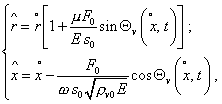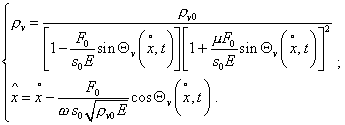| SELF | 26 |
S.B. Karavashkin and O.N. Karavashkina |
|
|
|
| To determine on the basis of (26) the variation of the
spatial density in a rod, we need to present |
|
|
(36) |
where  |
|
| Substituting (36) into (26) and noting (22), we yield | |
|
(37) |
| The same as in the above cases, to describe |
|
|
(38) |
| The obtained expression (38) also describes the deformed wave of a complex non-sinusoidal type. With the small ratio F0 to s0E this wave can be presented as a harmonic process. At | |
|
(39) |
the ruptures form in the rod, in the compression region; this determines the limiting value of the external affecting force. The expression (39) evidences that in frames of linear modelling the value of limiting load increases linearly with the cross-section growing.
|
|
| 5. Conclusions | |
We have revealed that the Poisson coefficient is actually the negative value. The propagation velocity of the accompanying transversal wave is equal to the velocity of longitudinal wave. And correspondingly, the velocity of the accompanying longitudinal wave is equal to the velocity of transversal wave, if the velocities of the main longitudinal and transversal waves were inequal. When the longitudinal compression wave propagates in linear models of an infinitesimally thin rod and a finite-cross-section rod, both the linear density for 1D elastic line and spatial density for a finite-cross-section rod vary in space and time after a non-harmonic periodical regularity. With the growing external exciting force, the wave transformation increases. With the amplitude of a dynamical load F0 equal to the rod stiffness T (or s0E for a finite-cross-section rod), in this last the density breakages form in the compression region. With it, in the tension region the density diminishes twice. The revealed value of the limiting load is overrated, which is caused by the linear modelling of the processes taking place in a rod. The transversal accompanying wave is in phase with the
external affecting force, and the phase of the longitudinal wave delays by In this way we have showed that the limits of linear modelling of dynamical processes in a rod considerably exceed the conventional condition based on a harmonic pattern of processes. |
|


